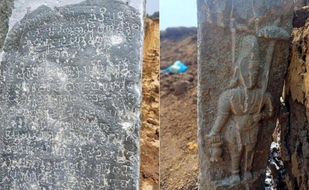Inscription from Vikramaditya I Era
Recently, archaeological discovery was made at Madapura Lake in Nyamati taluk, Davangere district. An inscription dating back to the 7th century AD was unearthed. This inscription, measuring five feet in length, contains 17 lines in Old Kannada script. It is attributed to the reign of Vikramaditya I of the Badami Chalukya dynasty, who ruled from 654 to 681 AD. The finding adds valuable vital information about the administration and social organisation of that period.
Vikramaditya I
Vikramaditya I was the third son of Pulakesin II. He ascended the throne after a period of instability from 642 to 655 AD. His reign is noted for restoring order and repelling the Pallava invasions. He successfully recaptured Vatapi and established strong governance across his territory.
Significance of the Inscription
The inscription reveals an administrative act by Singhavenna, an officer under Vikramaditya I. It records the waiver of taxes for local villagers, denoting welfare initiatives. Additionally, it notes a land donation of six acres for lake construction, showcasing early landholding patterns and community structures.
Administrative Divisions
The inscription indicates that Ballavi was administrative unit, comprising around 70 villages. This reflects a well-organised local governance system during the 7th century AD. The discovery provides a glimpse into the complexities of administrative divisions and governance in ancient Karnataka.
Cultural Continuity and Later Significance
An intriguing aspect of the inscription is the incomplete relief sculpture from the 17th century AD found on the stone slab. This suggests that the site maintained cultural or religious significance in later centuries. It implies a continuity of traditions and values beyond the initial inscription’s creation.
Month: Current Affairs - May, 2025
Category: Art & Culture Current Affairs






